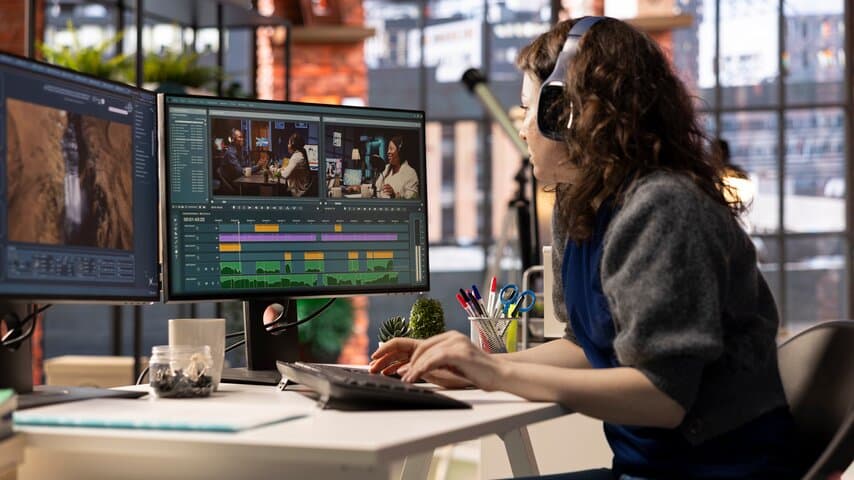Video algorithms catapult the smallest creator onto screens in Seoul, São Paulo, and Stockholm. To edit videos that hold diverse viewers, you need to marry universal storytelling with local flavour while respecting technical constraints.
Great localisation begins in pre-production and runs through post, disappearing into the finished cut as seamlessly as colour grading. This guide shows you how to think from first rough assembly to final export and reach to global audience.
Table of Contents
ToggleEditing videos for an international audience: important things to know
- Map regional priorities early
Identify your target territories, research their broadcasting standards and content restrictions, then document the findings in a one-page cheat sheet the whole crew can reference.
This proactive step influences set design, legal clearances, and even colour-palette choices, ultimately preventing costly reshoots.
- Plan for multilingual assets
Build your project with separate layers for dialogue, graphics, and text elements so translators can replace items quickly. Include a text-free “clean” pass in your deliverables list; when a new language is required six months later, you will not need to re-encode from a lossy copy.
- Study local viewing habits
Watch-time analytics reveal pacing preferences—German viewers may enjoy longer establishing shots, while Brazilians tend to favour energetic jump cuts. Rhythm and segment length do a lot for a video, improving retention without diluting your style.
- Schedule extra revision rounds
Subtitling, dubbing, and compliance checks each add tangible days, sometimes weeks, to the timeline. Blocking them into the master calendar keeps pressure low and leaves space for creative experimentation.
- Budget for additional audio work
Every new language introduces at least two more deliverables—a dialogue stem and a full-mix track—and often calls for alternate music cues because licensing deals vary by territory. Allocate studio time and money up front, so the soundtrack never becomes an afterthought.
How to adapt content for a global audience?
I. Consider language (subtitles, dubbing)
- Choose the right localisation mix
– subtitles are inexpensive and preserve original performances, but they require reading effort.
– voiceover adds narrator warmth while keeping location sound.
– full dubbing delivers the smoothest experience for drama but costs the most.
Match the method to genre, budget, and audience preference rather than defaulting to the cheapest option.
Tip: there are always cheat sheets for everything. For example, costs of dubbing can be cut with AI avatars and voice-cloning.
- Design for readability
Two-line captions in German or Portuguese can expand to thirty-five characters per line. This means short, quick dialogues would be easier to read.
Keep graphics out of the lower tenth of the frame and add subtle drop shadows to guarantee legibility against bright footage.
Fonts, colours, and text size should also be carefully chosen and be consistent throughout the video to keep it on the same visual level. Any video editor, like, for example, iMovie or alternatives of iMovie for Windows can do that easily (and more!).
- Preserve tone, not just words
Idioms and humour often fail in literal translation. Work with native writers who adapt punchlines and technical jargon, so jokes still land and instructions still teach.
Or include them in a video as a quick description to save time and translation costs.
II. Cultural specifics
- Visual symbolism matters
White symbolizes purity in much of the West yet mourning in East Asia, and a green hat in China implies infidelity. Test colour palettes and iconography with regional consultants to avoid accidental offence.
- Humour and references need localisation
A pun about baseball statistics may fall flat where cricket dominates; consider filming alternate punchlines or inserting a local influencer cameo to keep laughs universal.
- Sensitive content varies by region
Violence thresholds, depictions of romance, and political imagery face different regulations worldwide. Knowing these limits early guides shot choices and prevents expensive paint-outs later.
III. Technical requirements (video formats, platforms)
- Aspect ratios demand foresight
Shooting slightly wider lets you crop a 16 : 9 master into 9 : 16 or 1 : 1 without slicing off critical action. Mark safe zones on set monitors, so cinematographers keep essentials centred.
- Codecs and delivery specs shift constantly
YouTube accepts H.264, while many OTT services prefer H.265 or ProRes for HDR. Maintain a high-bit-rate mezzanine file so you can encode downward quickly whenever a platform changes its rules.
- Metadata is crucial
Mislabelled language codes or incorrect loudness targets can trigger rejection queues. Automate metadata checks in your export presets, so every upload sails through first review.
IV. Local trends
- Music charts and memes fuel engagement
A trending Afro-beat sample in your Nigerian cut sparks instant recognition and shareability. Always negotiate territory-wide sync rights before committing.
- Influencer collaborations build trust
A ten-second cameo from a beloved Danish gamer signals, “This story includes you,” and can boost watch-through rates more than an entire minute of polished ad copy.
- Holiday timing multiplies reach
Family-centric clips launched ahead of Diwali or Ramadan tap into festive spirits and looser work schedules, increasing shares.
- Visual style preferences vary
South-East Asian beauty vlogs lean pastel and airy, whereas Scandinavian tech reviews favour minimalist design. Borrow local style cues to avoid feeling imported.
Workflow and collaboration across borders
- Define overlap hours: Pick a daily two-hour slot when Los Angeles, London, and Manila teams are awake, using that window for live reviews, so feedback cycles never exceed twenty-four hours.
- Establish a single source of truth: Store masters and reference files on a cloud platform with version control. By forcing everyone to comment on the same render, you eliminate the notorious “final_v7_REAL_FINAL” confusion.
- Use structured feedback forms: Templates that request timecode, issue description, and proposed fix turn vague reactions into actionable edits, saving hours of guesswork.
- Automate notifications: Slack or Teams bots can ping linguists and QC leads the moment a new cut syncs, reducing idle time between stages.
- Document brand and style rules: A shared guide covering typography, tone, and motion style prevents subjective disputes, speeds decisions, and keeps replacements aligned.
Legal and ethical considerations
- Secure worldwide licensing. A song cleared for North America can still trigger takedowns in Europe. Confirm your agreements specify every territory in which the video will appear, plus future platforms you might adopt.
- Respect privacy laws. Faces captured in public might need releases under Europe’s GDPR (and any other country law). Track consent forms in a searchable database to demonstrate compliance quickly.
- Meet accessibility mandates. The U.S. CVAA, Canada’s ACA, and India’s disability guidelines each outline caption standards. Build transcription into the schedule rather than tacking it on last minute.
- Disclose sponsorships transparently. Hashtags like #ad or on-screen “paid partnership” supers must appear in the local language and meet size guidelines to satisfy regulators.
- Monitor archival consent expiry. In some jurisdictions, minors can revoke their appearance on reaching adulthood. Schedule rights audits so you are never blindsided by a takedown request.
Practical tips on editing videos
- Keep folder structures predictable. Nested directories labelled by asset type and language save assistants from hunting for one rogue PNG while the director waits.
- Turn graphics into smart templates. Motion graphics templates lock font, colour, and animation presets, allowing junior editors to update titles in six languages without touching keyframes.
- Leverage visual storytelling first. The more action happens through performance and framing, the fewer words need translation, and the more universal the emotional punch.
- Maintain clean audio stems. Separate dialogue, effects, ambience, and music on discrete buses so you can duck tracks precisely beneath foreign narration.
- Test on multiple devices. Play a near-final cut on a budget phone; if captions remain crisp and the mix clear, premium viewers will enjoy an even better experience.
- Automate repetitive tasks wisely. AI transcribers free human linguists to focus on nuance, and watch-folder encoders generate platform proxies while you sleep.
- Uphold brand consistency. Every time you edit videos within style-guide rules, you strengthen brand equity that viewers recognize instantly. And that includes written vs spoken language too.
Future-proofing your global content
- Capture more resolution than you need today
Extra pixels let you master tomorrow’s 12K VR headset format or crop new vertical teasers without reshooting.
Shooting in a log color space also preserves dynamic range for HDR deliverables that may become mandatory.
- Store layered projects off-site
Cloud backups with checksum verification mean a spilled coffee or lost drive never erases months of work. Keeping audio, graphics, and colour grades unflattened ensures you can tweak elements individually when standards evolve.
- Experiment with AI localisation tools
Voice cloning and automated lip-sync are improving fast, yet they still mispronounce brand names and trip over sarcasm. Run pilot tests on short clips, compare against human performance, and keep an editor in the loop until accuracy reaches broadcast quality.
- Refresh evergreen hits.
Annual subtitle updates, new call-to-action bumpers, or colour-space upgrades can revive a two-year-old engaging video, doubling its lifetime revenue with minimal spend. Treat content as a living asset rather than a disposable post.
Thinking beyond tomorrow’s release date turns every project into an appreciating resource that scales effortlessly with new formats and audiences.
Conclusion
International audiences crave stories that feel native yet offer fresh perspectives. Weaving localisation into creative strategy means embracing multilingual workflows, cultural insight, meticulous compliance, and forward-looking technology.
This way you transform each project into a borderless story. Apply some editing techniques, and your next upload will not simply cross borders; it will build lasting bridges with viewers worldwide.






















